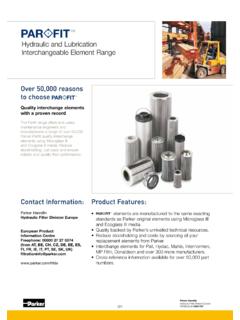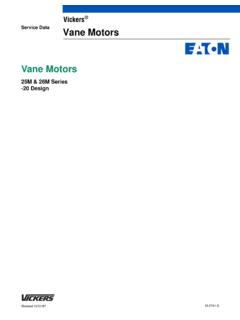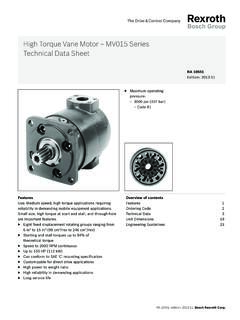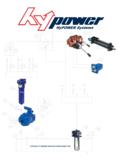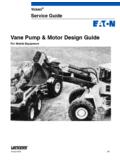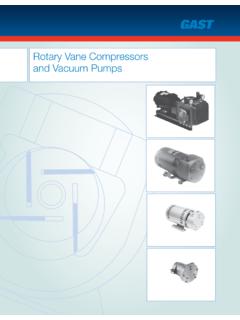Transcription of Pneumatic Air Motors - SEALL
1 Pneumatic Air Motorsaerospaceclimate control el ectromechanical ltration uid & gas handlinghydraulicspneumaticspr ocess controlsealing & shieldingP1V-A large type: , & kWP1V-B very large type: , 9 & 18 kWCatalogue PDE2670 TCUK May 20142 Parker Hannifin CorporationPneumatic Division - EuropePDE2670 TCUKP1V-A & B Air Motors ContentsGeneralFeatures .. 3 - 4 Principles of air Motors .. 5 The steps to size .. 6 - 10 Air quality .. 11 Large Air Motors P1V-A .. 13 Very Large Air Motors P1V-B .. 47 SALE CONDITIONSThe items described in this document are available for sale by Parker Hannifin Corporation, its subsidiaries or its authorized distributors. Any sale contract entered into by Parker will be governed by the provisions stated in Parker s standard terms and conditions of sale (copy available upon request).WARNINGFAILURE OR IMPROPER SELECTION OR IMPROPER USE OF THE PRODUCTS AND/OR SYSTEMS DESCRIBED HEREIN OR RELATED ITEMS CAN CAUSE DEATH, PERSONAL INJURY ANDPROPERTY document and other information from Parker Hannifin Corporation, its subsidiaries and authorized distributors provide product and/or system options for further investigation by users having technical expertise.
2 It is important that you analyze all aspects of your application and review the information concerning the product or system in the current product catalog. Due to the variety of operating conditions and applications for these products or systems, the user, through its own analysis and testing, is solely responsible for making the final selection of the products and systems and assuring that all performance, safety and warning requirements of the application are met. The products described herein, including without limitation, product features, specifications, designs, availability and pricing, are subject to change by Parker Hannifin Corporation and its subsidiaries at any time without technical data in the catalogue are typical va-lues. The air quality is a major factor in the service life of the motor , see ISO carrying out service activities, make sure the air motor is vented.
3 Before disassembling the motor , disconnect the primary air hose to ensure that the air supply is Hannifin CorporationPneumatic Division - EuropePDE2670 TCUKP1V-A & B Air MotorsFeatures Air motor Hydraulic motor Electric motorOverload safe ** ** *Increased torque at higher loads ** ** *Easy to limit torque ** ** *Easy to vary speed ** ** *Easy to limit power ** ** *Reliability ** ** **Robustness ** ** *Installation cost ** * **Ease of service ** ** *Safety in damp environments ** ** *Safety in explosive atmospheres ** ** *Safety risk with electrical installations ** ** *Risk of oil leak ** * **Hydraulic system required ** * **Weight ** ** *Power density ** ** *High torque for size ** ** *Noise level during operation * ** **Total energy consumption * ** **Service interval * ** **Compressor capacity required * ** **Purchase price * * ** = good, **=average.
4 **=excellent4 Parker Hannifin CorporationPneumatic Division - EuropePDE2670 TCUKP1V-A & B Air Motors Air Motors have much smaller installation dimensions than corresponding electric Motors can be loaded until they stall, without damage. They are designed to be able to withstand the toughest heat, vibration, impact weight of an air motor is several times less than corresponding electric Motors can be used in the harshest Motors can be stopped and started continually without simple design principle of air Motors make them very easy to Motors are reversible as reliability of air Motors is very high, thanks to the design and the low number of moving Hannifin CorporationPneumatic Division - EuropePDE2670 TCUKP1V-A & B Air Motors5123451234 Principles of air motor functionningThere are a number of designs of air motor . Parker has chosen to use the vane rotor design, because of its simple design and reliable operation.
5 The small external dimensions of vane Motors make them suitable for all applications. The principle of the vane motor is that a rotor with a number of vanes is enclosed in a rotor cylinder. The motor is supplied with compressed air through one connection and air escapes from the other connection. To give reliable starting, the springs press the vanes against the rotor cylinder. The air pressure always bears at right angles against a surface. This means that the torque of the motor is a result of the vane surfaces and the air Rotor cylinder2 Rotor3 Vanes4 Spring5 End piece with bearingThe performance characteristics of each motor are shown in a family of curves as above, from which torque, power and air consumption can be read off as a function of speed. Power is zero when the motor is stationary and also when running at free speed (100%) with no load.
6 Maximum power (100%) is normally developed when the motor is driving a load at approximately half the free speed (50%).Torque at free speed is zero, but increases as soon as a load is applied, rising linearly until the motor stalls. As the motor can then stop with the vanes in various positions, it is not possible to specify an exact torque. However, a minimum starting torque is shown in all consumption is greatest at free speed, and decreases with decreasing speed, as shown in the above , power and air consumption graphsOutletOutletInlet, leftInlet, right402060 8010016012014020018010010020406080204060 80 MQPQ [%], P [%]M [%]n [%]P = powerM = torqueQ = air consumptionn = speedPossible working range of working range of speeds = more vane wearLower speeds with high torque = more gearbox wear6 Parker Hannifin CorporationPneumatic Division - EuropePDE2670 TCUKP1V-A & B Air Motors Choosing the correct air motor for your application 1 Which drive principle of the air motor is suitable for your application?
7 - Air vane motor are suitable for regular operating cycles, speed is very small 16 rpm - Tooth gear air motor or turbines are more suitable for continuous operation, 24 hours non-stop, speed is in a upper range, up to 140,000 rpm - Oil free operation is often an option for these three priciples of air Motors . Be aware that there is a reduction of performance between -10 to 20%. 2 Which motor materials are suitable for your application? - Will the air motor work in a normal production area - Or in a paper industry - Or in the food processing industry, in contact or not with food - Or in underwater usage - Or in the medical, pharmaceutical industries - Or in potentially explosive areas - Others, please describe your environment 3 How do you calculate the motor power taking the application conditions into consideration?
8 1. Which rotational direction? Clockwise, anti-clockwise, reversible? 2. Air pressure working range? Which air class quality is available? 3. Which torque and which speed under load do you expect to obtain? 4. Calculate the basic power with the formula P = M x n / 95550 with P power output in kW, M nominal torque in Nm, n nominal speed in rpm 5. Check performance data of air Motors in our catalogues. Note that all data is at 6 bar in the inlet of the air motor , max 3 meters for tubes and oil lubricated operations. 6. To adapt the difference of air pressure with your operation conditions, please check graphs in our catalogues and how to do it. 7. or you can adapt the need of air to fit your operation conditions by throttling the outlet flow in the air motor you will reduce speed without loss of torque.
9 8. Check if you need an oil free or not working operation. 1 to 2 drops of oil per cube meter are needed to optimize performance and life time of air Motors . Oil free operation will decrease by 10 to 20% the performance of air Motors . 4 How do you integrate your air motor in your system? - In which position is the air motor used? - Do you need to use a brake? - Do you want to use your own gear box and put it somewhere else in the machine? - Do you need extra components like fittings, tubes, valves and FRLs? 5 How do you ensure a long life and high performance of the air motor ? - Ensure you air quality is in accordance with our specifications, oil or free oil lubrication operations. - Keep the recommended maintenance intervals 6 How do you determine the purchasing and running costs after the air motor installation?
10 - Keep same level of your air Hannifin CorporationPneumatic Division - EuropePDE2670 TCUKP1V-A & B Air MotorsIntroductionThe performance of an air motor is dependent on the inlet pressure. At a constant inlet pressure, air Motors exhibit the characteristic linear output torque / speed relationship. However, by simply regulating the air supply, using the techniques of throttling or pressure regulation, the output of an air motor can easily be modified. The most economical operation of an air motor (least wear, least air consumption, etc.) is reached by running close to nominal speed. By torque of M = 0, the maximum speed (idle speed) is reached. Shortly before standstill (n - 0), the air motor reaches its maximum torque (Mmax = 2 x Mo). At nominal speed (nn), for example in the middle of the speed range, air motor reaches its maximum power output (Pmax).

